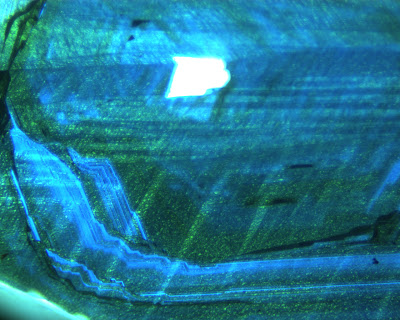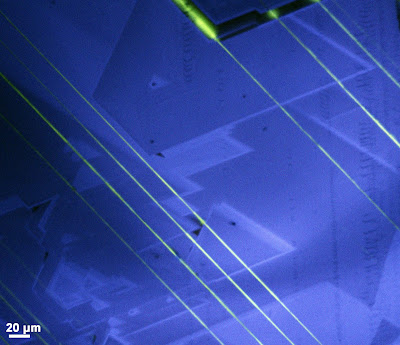It sounds like a trivial question, right? Well, the answer is no. But first of all, let me introduce you to a few celebrities and the record prices they drew at recent auctions.
CELEBRITIES:
The 24.78 ct Graff Pink diamond sold for $46 million at a Sotherby's auction in 2010. It is the most expensive gem ever sold at an auction. This diamond is a type IIa diamond (no detectable nitrogen impurity by infrared spectroscopy) graded "Fancy Intense Pink" (Sotherby's picture).
The 12.04 ct "Martian Pink" diamond sold for $17.4 million at a Christie's auction in May 2012. Another rare type IIa diamond, graded "Fancy Intense Pink" as well (Christie's picture).
The 8.20 ct "Fancy Intense Purplish-Pink diamond" sold for $2,042,500 at a Christie's auction in 2011 (Christie's picture).
Well, to be honest, the pink color in diamond is one of the least understood by scientists. I have been conducting research on the subject over the past 5 years, and my colleagues and I came to a better understanding of these diamonds. It looks like the geologic setting has a lot to do with the origin of the color. Pink diamonds don't grow up with a pink color: it is an post-growth process in a rough/turbulent Earth's mantle that diamonds can acquire a pink color.
Here is a quick summary of the research I have been conducted with my colleagues at the Smithsonian Institution and at the Naval Research Lab.
Click to read more!
THE NATURE OF THE PINK COLOR IN NATURAL DIAMONDS.
Fig. 1: The 5.05 Kajanjian Red diamond is just a very deep "pink" diamond. The origin of the color is similar to the lightly colored pink diamonds. Red diamonds are extremely rare, and this 5.05 ct red is among the 3 biggest red diamonds ever cut (Tino Hammid photo).
The origin of the pink color, which sometimes has a purple hue or a dark tone (sometimes described as “red”, such as the Kajanjian Red diamond, see Fig.1), is still not completely understood. Plastic deformation (deformation of a material without breaking) is known to play an important role in the development of pink lamellae or “graining” within colorless diamonds: for almost all pink diamonds, the color is not homogeneous, but instead, colorless and pink areas alternate. The pink areas would be where the most deformation would have happened inside the mineral.
The color is the result of a broad absorption band centered at about 550-560 nm that absorbs most of the visible spectrum except for the red. So far, the cause of this absorption feature is unknown, and unfortunately, the center, or other defect that is responsible for the absorption does not seem to be active in any other spectroscopic mode.
In our study (Gaillou et al., 2010), we recognized that there are two distinct groups of type Ia (that is, containing nitrogen impurities in aggregate states) natural pink diamonds:
- group 1: Natural pink diamonds from Argyle in Australia and from Santa Elena in Venezuela.
Even if the rough looks homogeneous in color (Fig. 2), when cut in the right orientation the pink areas form wavy bands inside a colorless diamond (Fig. 3).
Fig. 2: A pink diamond from Argyle, Australia.
Fig. 3a: Slice of pink diamond from Argyle, polished perpendicularly to the pink graining. Wavy bands of colorless/pink areas are visible.
Fig 3b: Same slice of pink diamond from Argyle, viewed in between cross-polarizers. The remaining stress represented by anomalous birefringence follows the main directions of the pink color.
- group 2: Natural pink diamonds from other localities (including: Brazil as seen in Fig 4, Canada, Russia, Siberia, South Africa and Tanzania).
For these diamonds, the pink color is restricted to thin pink lamellae in a colorless diamond (see Fig. 5).
Fig. 4: Rough diamond from Brazil.
Fig. 5a: Slice of pink diamond (group 2).
Fig. 5b: Same diamond, wider angle, with a polarizer in the way.
Fig 5c: Same diamond, in between polarizer. It is clear that the highest remaining strain is localized at and around the pink lamellae.
These 2 groups present spectroscopic features that are different (by Raman spectroscopy, cathodoluminescence, photoluminescence); they are extensively described in Gaillou et al. (2010). Examples of cathodoluminescence imagery are given in Fig. 6 & 7. In all cases though, all the defects involved nitrogen aggregates associated with vacancies (such as the new 405.5 nm center and the well known H3 center).
Fig. 6: Cathodoluminescence picture of a pink Argyle diamond (group 1). In blue: growth sectors (N3 centers), in green: H3 centers describing a "fish-scale" pattern.
Fig. 7: Cathodoluminescence image of a pink diamond (group 2).
The pink lamellae emit a green CL (H3 centers + less intense 405.5 nm center), the colorless diamond emit a blue luminescence (from the "blue band", also called "band A"). For the second group of diamond, it was recently suggested (Mineeva et al., 2009) and then confirmed (Gaillou et al., 2010; Titkov et al., 2012) that plastic deformation and subsequent annealing is manifested by the presence of pairs of twin planes. No similar studies have been conducted on group 1 diamonds so far, so we can only speculate that similar processes happen for group 2 diamonds.
We proposed that to accommodate deformation, mechanical twinning takes place, which also creates vacancies. With time and the high temperature existing in the Earth's mantle, the vacancies created at the twins can move to the next nitrogen aggregates (here, most likely A-aggregates) to form the new 405.5 nm center, the H3 center, and the center responsible for the pink color. The differences in the plastic deformation features, and resulting CL properties, for the two groups might correlate to the particular geologic conditions under which the diamonds formed. Pink diamonds from Argyle and Santa Elena are deposits located within the "young" Proterozoic cratons, which experienced a high geothermal activities about 1.6 Ga. These diamonds indeed present features of high temperature residence (such as a high nitrogen aggregation state... and an intense plastic deformation). Diamonds from other localities mostly originate from the older Archean cratons, at comparatively lower temperatures.
To learn more about this, dowload the pdf of the article.
Subscribe to our blog and we will keep you posted on gem / mineral news and on publication (one soon to be published about the cathodoluminescence of pink diamonds!).
The Argyle Pink Jubilee: the largest rough pink diamond, weighing12.76 ct, unearthed in Australia, as of this day (Rio Tinto's photo).


















Very Nice Diamond. Ashoka Diamond Ring
ReplyDeleteIs this topic connected with your occupation or is it mostly about your hobbies and free time?
ReplyDelete